University Essay: Parent-Child Communication and Harmful Behavior
VerifiedAdded on 2023/06/03
|7
|1501
|77
Essay
AI Summary
This essay critically analyzes an online article claiming that enhanced parent-child communication in early development reduces harmful behaviors like alcohol misuse and emotional eating. The study, conducted over 14 years, focused on African American communities and explored the link between communication, brain development, and behavioral patterns. The essay discusses the study's assumptions, methodology, and findings, highlighting the correlation between strong parent-child bonds and optimized brain development. It also examines the limitations of the study, particularly its focus on a single community, and suggests areas for future research, emphasizing the importance of communication in shaping children's behavioral outcomes. The essay concludes by affirming the study's hypothesis while acknowledging its limitations.
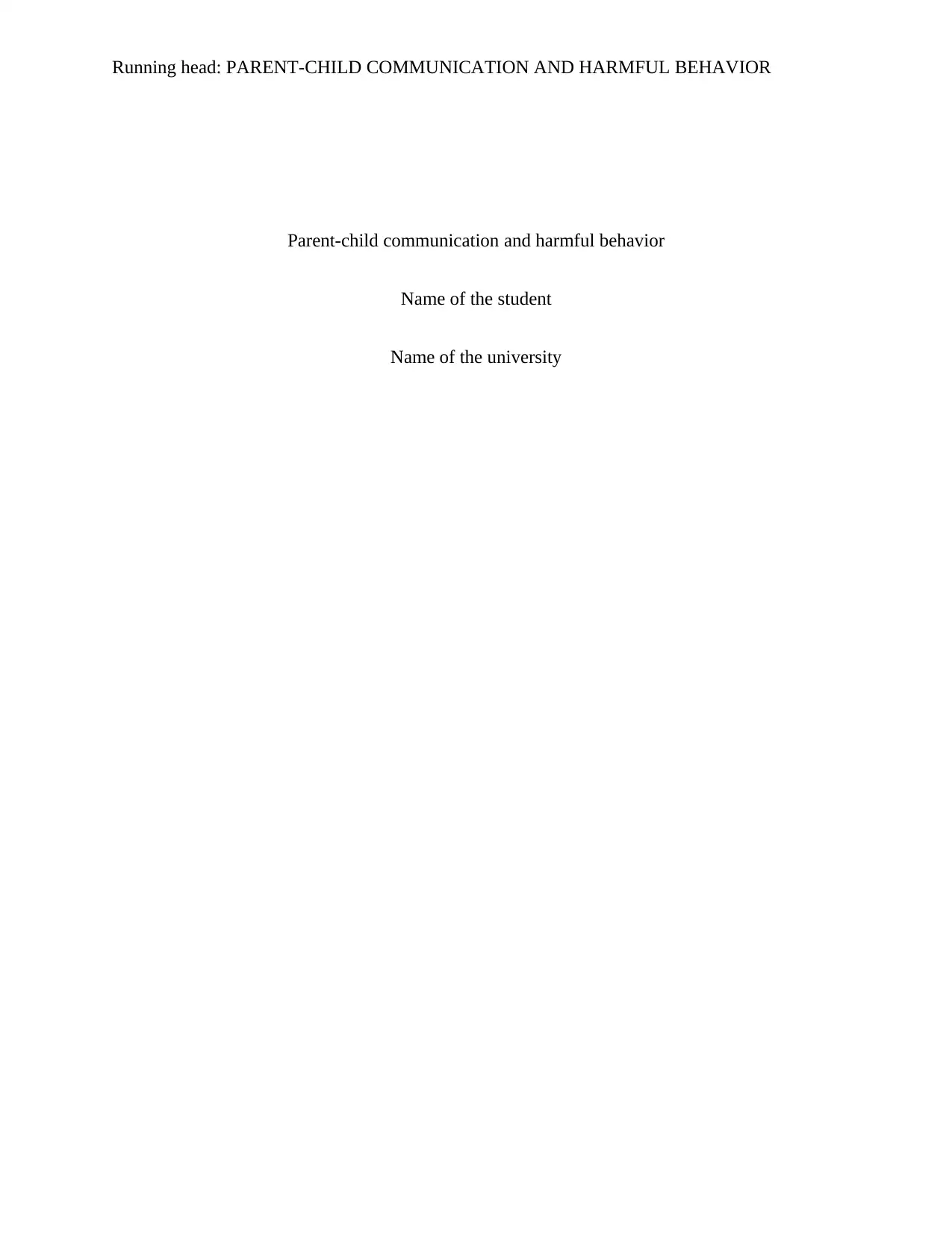
Running head: PARENT-CHILD COMMUNICATION AND HARMFUL BEHAVIOR
Parent-child communication and harmful behavior
Name of the student
Name of the university
Parent-child communication and harmful behavior
Name of the student
Name of the university
Paraphrase This Document
Need a fresh take? Get an instant paraphrase of this document with our AI Paraphraser
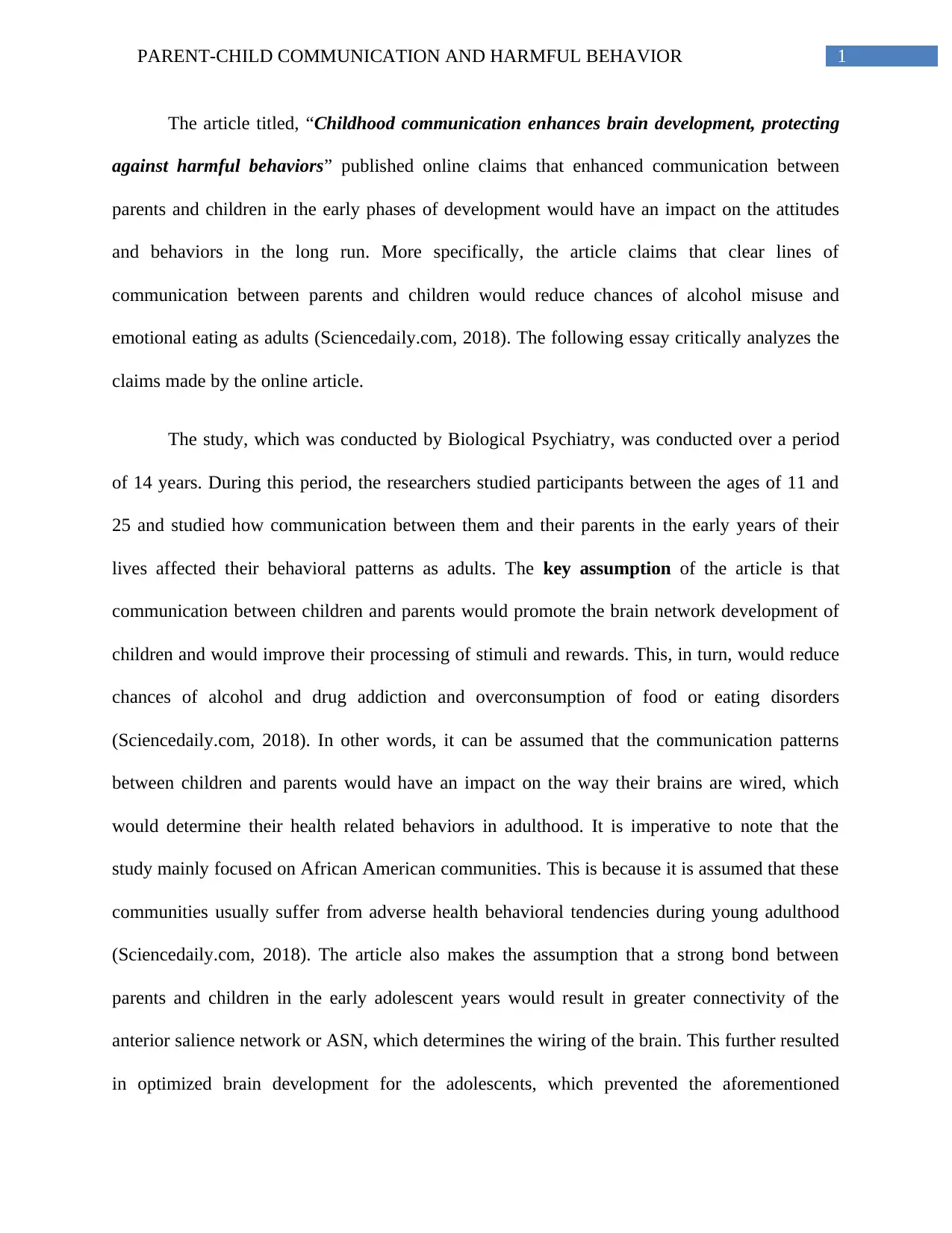
1PARENT-CHILD COMMUNICATION AND HARMFUL BEHAVIOR
The article titled, “Childhood communication enhances brain development, protecting
against harmful behaviors” published online claims that enhanced communication between
parents and children in the early phases of development would have an impact on the attitudes
and behaviors in the long run. More specifically, the article claims that clear lines of
communication between parents and children would reduce chances of alcohol misuse and
emotional eating as adults (Sciencedaily.com, 2018). The following essay critically analyzes the
claims made by the online article.
The study, which was conducted by Biological Psychiatry, was conducted over a period
of 14 years. During this period, the researchers studied participants between the ages of 11 and
25 and studied how communication between them and their parents in the early years of their
lives affected their behavioral patterns as adults. The key assumption of the article is that
communication between children and parents would promote the brain network development of
children and would improve their processing of stimuli and rewards. This, in turn, would reduce
chances of alcohol and drug addiction and overconsumption of food or eating disorders
(Sciencedaily.com, 2018). In other words, it can be assumed that the communication patterns
between children and parents would have an impact on the way their brains are wired, which
would determine their health related behaviors in adulthood. It is imperative to note that the
study mainly focused on African American communities. This is because it is assumed that these
communities usually suffer from adverse health behavioral tendencies during young adulthood
(Sciencedaily.com, 2018). The article also makes the assumption that a strong bond between
parents and children in the early adolescent years would result in greater connectivity of the
anterior salience network or ASN, which determines the wiring of the brain. This further resulted
in optimized brain development for the adolescents, which prevented the aforementioned
The article titled, “Childhood communication enhances brain development, protecting
against harmful behaviors” published online claims that enhanced communication between
parents and children in the early phases of development would have an impact on the attitudes
and behaviors in the long run. More specifically, the article claims that clear lines of
communication between parents and children would reduce chances of alcohol misuse and
emotional eating as adults (Sciencedaily.com, 2018). The following essay critically analyzes the
claims made by the online article.
The study, which was conducted by Biological Psychiatry, was conducted over a period
of 14 years. During this period, the researchers studied participants between the ages of 11 and
25 and studied how communication between them and their parents in the early years of their
lives affected their behavioral patterns as adults. The key assumption of the article is that
communication between children and parents would promote the brain network development of
children and would improve their processing of stimuli and rewards. This, in turn, would reduce
chances of alcohol and drug addiction and overconsumption of food or eating disorders
(Sciencedaily.com, 2018). In other words, it can be assumed that the communication patterns
between children and parents would have an impact on the way their brains are wired, which
would determine their health related behaviors in adulthood. It is imperative to note that the
study mainly focused on African American communities. This is because it is assumed that these
communities usually suffer from adverse health behavioral tendencies during young adulthood
(Sciencedaily.com, 2018). The article also makes the assumption that a strong bond between
parents and children in the early adolescent years would result in greater connectivity of the
anterior salience network or ASN, which determines the wiring of the brain. This further resulted
in optimized brain development for the adolescents, which prevented the aforementioned
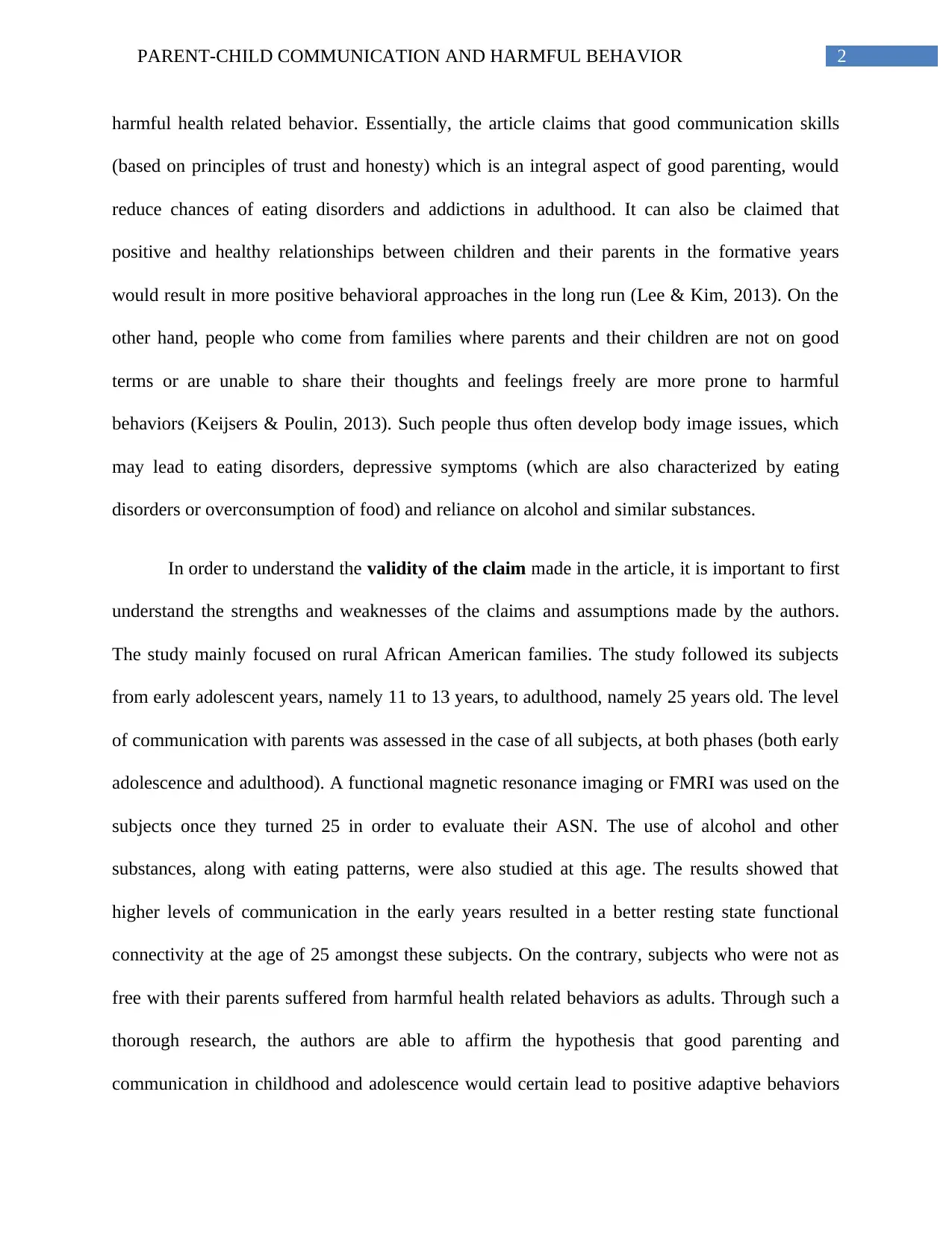
2PARENT-CHILD COMMUNICATION AND HARMFUL BEHAVIOR
harmful health related behavior. Essentially, the article claims that good communication skills
(based on principles of trust and honesty) which is an integral aspect of good parenting, would
reduce chances of eating disorders and addictions in adulthood. It can also be claimed that
positive and healthy relationships between children and their parents in the formative years
would result in more positive behavioral approaches in the long run (Lee & Kim, 2013). On the
other hand, people who come from families where parents and their children are not on good
terms or are unable to share their thoughts and feelings freely are more prone to harmful
behaviors (Keijsers & Poulin, 2013). Such people thus often develop body image issues, which
may lead to eating disorders, depressive symptoms (which are also characterized by eating
disorders or overconsumption of food) and reliance on alcohol and similar substances.
In order to understand the validity of the claim made in the article, it is important to first
understand the strengths and weaknesses of the claims and assumptions made by the authors.
The study mainly focused on rural African American families. The study followed its subjects
from early adolescent years, namely 11 to 13 years, to adulthood, namely 25 years old. The level
of communication with parents was assessed in the case of all subjects, at both phases (both early
adolescence and adulthood). A functional magnetic resonance imaging or FMRI was used on the
subjects once they turned 25 in order to evaluate their ASN. The use of alcohol and other
substances, along with eating patterns, were also studied at this age. The results showed that
higher levels of communication in the early years resulted in a better resting state functional
connectivity at the age of 25 amongst these subjects. On the contrary, subjects who were not as
free with their parents suffered from harmful health related behaviors as adults. Through such a
thorough research, the authors are able to affirm the hypothesis that good parenting and
communication in childhood and adolescence would certain lead to positive adaptive behaviors
harmful health related behavior. Essentially, the article claims that good communication skills
(based on principles of trust and honesty) which is an integral aspect of good parenting, would
reduce chances of eating disorders and addictions in adulthood. It can also be claimed that
positive and healthy relationships between children and their parents in the formative years
would result in more positive behavioral approaches in the long run (Lee & Kim, 2013). On the
other hand, people who come from families where parents and their children are not on good
terms or are unable to share their thoughts and feelings freely are more prone to harmful
behaviors (Keijsers & Poulin, 2013). Such people thus often develop body image issues, which
may lead to eating disorders, depressive symptoms (which are also characterized by eating
disorders or overconsumption of food) and reliance on alcohol and similar substances.
In order to understand the validity of the claim made in the article, it is important to first
understand the strengths and weaknesses of the claims and assumptions made by the authors.
The study mainly focused on rural African American families. The study followed its subjects
from early adolescent years, namely 11 to 13 years, to adulthood, namely 25 years old. The level
of communication with parents was assessed in the case of all subjects, at both phases (both early
adolescence and adulthood). A functional magnetic resonance imaging or FMRI was used on the
subjects once they turned 25 in order to evaluate their ASN. The use of alcohol and other
substances, along with eating patterns, were also studied at this age. The results showed that
higher levels of communication in the early years resulted in a better resting state functional
connectivity at the age of 25 amongst these subjects. On the contrary, subjects who were not as
free with their parents suffered from harmful health related behaviors as adults. Through such a
thorough research, the authors are able to affirm the hypothesis that good parenting and
communication in childhood and adolescence would certain lead to positive adaptive behaviors
⊘ This is a preview!⊘
Do you want full access?
Subscribe today to unlock all pages.

Trusted by 1+ million students worldwide
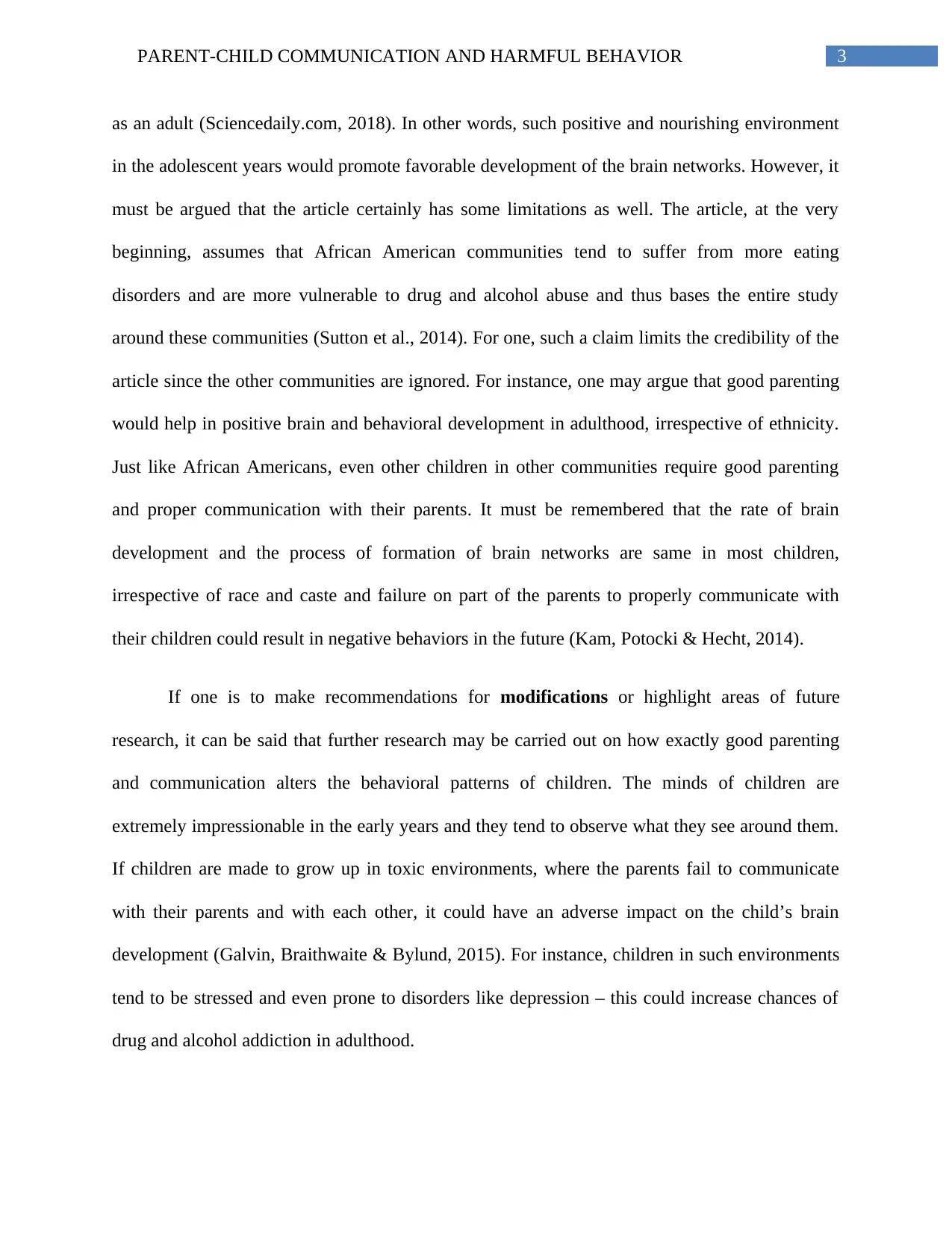
3PARENT-CHILD COMMUNICATION AND HARMFUL BEHAVIOR
as an adult (Sciencedaily.com, 2018). In other words, such positive and nourishing environment
in the adolescent years would promote favorable development of the brain networks. However, it
must be argued that the article certainly has some limitations as well. The article, at the very
beginning, assumes that African American communities tend to suffer from more eating
disorders and are more vulnerable to drug and alcohol abuse and thus bases the entire study
around these communities (Sutton et al., 2014). For one, such a claim limits the credibility of the
article since the other communities are ignored. For instance, one may argue that good parenting
would help in positive brain and behavioral development in adulthood, irrespective of ethnicity.
Just like African Americans, even other children in other communities require good parenting
and proper communication with their parents. It must be remembered that the rate of brain
development and the process of formation of brain networks are same in most children,
irrespective of race and caste and failure on part of the parents to properly communicate with
their children could result in negative behaviors in the future (Kam, Potocki & Hecht, 2014).
If one is to make recommendations for modifications or highlight areas of future
research, it can be said that further research may be carried out on how exactly good parenting
and communication alters the behavioral patterns of children. The minds of children are
extremely impressionable in the early years and they tend to observe what they see around them.
If children are made to grow up in toxic environments, where the parents fail to communicate
with their parents and with each other, it could have an adverse impact on the child’s brain
development (Galvin, Braithwaite & Bylund, 2015). For instance, children in such environments
tend to be stressed and even prone to disorders like depression – this could increase chances of
drug and alcohol addiction in adulthood.
as an adult (Sciencedaily.com, 2018). In other words, such positive and nourishing environment
in the adolescent years would promote favorable development of the brain networks. However, it
must be argued that the article certainly has some limitations as well. The article, at the very
beginning, assumes that African American communities tend to suffer from more eating
disorders and are more vulnerable to drug and alcohol abuse and thus bases the entire study
around these communities (Sutton et al., 2014). For one, such a claim limits the credibility of the
article since the other communities are ignored. For instance, one may argue that good parenting
would help in positive brain and behavioral development in adulthood, irrespective of ethnicity.
Just like African Americans, even other children in other communities require good parenting
and proper communication with their parents. It must be remembered that the rate of brain
development and the process of formation of brain networks are same in most children,
irrespective of race and caste and failure on part of the parents to properly communicate with
their children could result in negative behaviors in the future (Kam, Potocki & Hecht, 2014).
If one is to make recommendations for modifications or highlight areas of future
research, it can be said that further research may be carried out on how exactly good parenting
and communication alters the behavioral patterns of children. The minds of children are
extremely impressionable in the early years and they tend to observe what they see around them.
If children are made to grow up in toxic environments, where the parents fail to communicate
with their parents and with each other, it could have an adverse impact on the child’s brain
development (Galvin, Braithwaite & Bylund, 2015). For instance, children in such environments
tend to be stressed and even prone to disorders like depression – this could increase chances of
drug and alcohol addiction in adulthood.
Paraphrase This Document
Need a fresh take? Get an instant paraphrase of this document with our AI Paraphraser
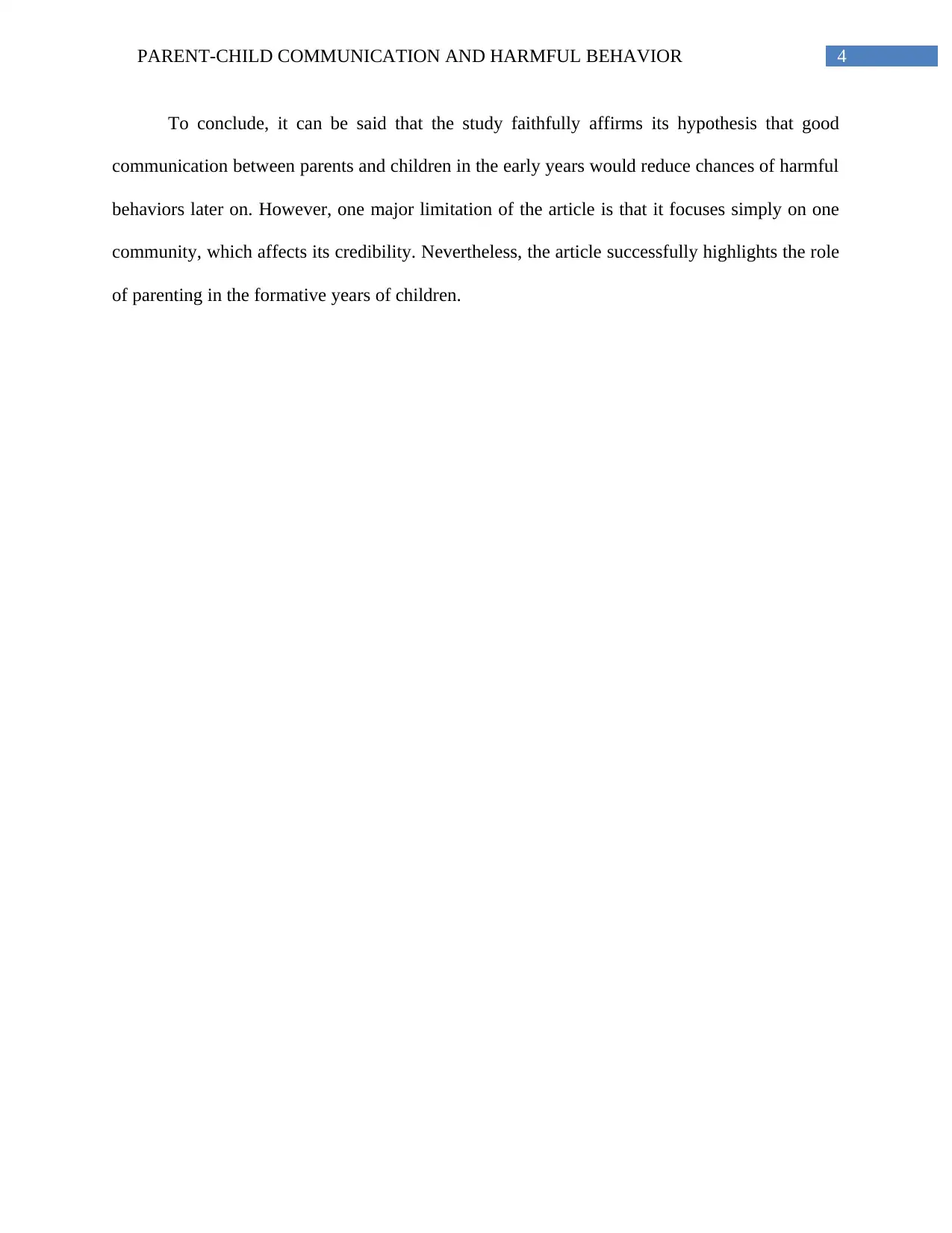
4PARENT-CHILD COMMUNICATION AND HARMFUL BEHAVIOR
To conclude, it can be said that the study faithfully affirms its hypothesis that good
communication between parents and children in the early years would reduce chances of harmful
behaviors later on. However, one major limitation of the article is that it focuses simply on one
community, which affects its credibility. Nevertheless, the article successfully highlights the role
of parenting in the formative years of children.
To conclude, it can be said that the study faithfully affirms its hypothesis that good
communication between parents and children in the early years would reduce chances of harmful
behaviors later on. However, one major limitation of the article is that it focuses simply on one
community, which affects its credibility. Nevertheless, the article successfully highlights the role
of parenting in the formative years of children.
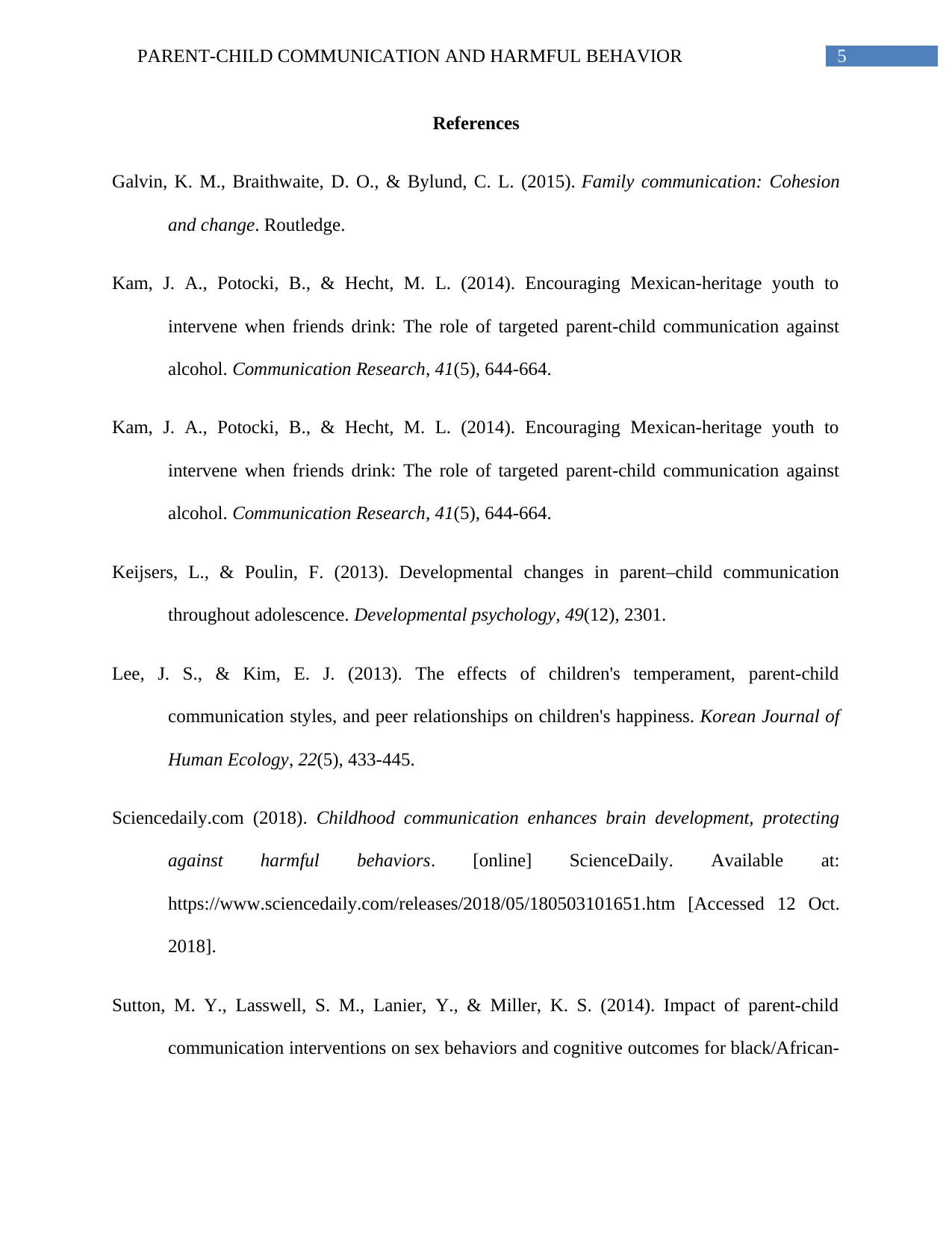
5PARENT-CHILD COMMUNICATION AND HARMFUL BEHAVIOR
References
Galvin, K. M., Braithwaite, D. O., & Bylund, C. L. (2015). Family communication: Cohesion
and change. Routledge.
Kam, J. A., Potocki, B., & Hecht, M. L. (2014). Encouraging Mexican-heritage youth to
intervene when friends drink: The role of targeted parent-child communication against
alcohol. Communication Research, 41(5), 644-664.
Kam, J. A., Potocki, B., & Hecht, M. L. (2014). Encouraging Mexican-heritage youth to
intervene when friends drink: The role of targeted parent-child communication against
alcohol. Communication Research, 41(5), 644-664.
Keijsers, L., & Poulin, F. (2013). Developmental changes in parent–child communication
throughout adolescence. Developmental psychology, 49(12), 2301.
Lee, J. S., & Kim, E. J. (2013). The effects of children's temperament, parent-child
communication styles, and peer relationships on children's happiness. Korean Journal of
Human Ecology, 22(5), 433-445.
Sciencedaily.com (2018). Childhood communication enhances brain development, protecting
against harmful behaviors. [online] ScienceDaily. Available at:
https://www.sciencedaily.com/releases/2018/05/180503101651.htm [Accessed 12 Oct.
2018].
Sutton, M. Y., Lasswell, S. M., Lanier, Y., & Miller, K. S. (2014). Impact of parent-child
communication interventions on sex behaviors and cognitive outcomes for black/African-
References
Galvin, K. M., Braithwaite, D. O., & Bylund, C. L. (2015). Family communication: Cohesion
and change. Routledge.
Kam, J. A., Potocki, B., & Hecht, M. L. (2014). Encouraging Mexican-heritage youth to
intervene when friends drink: The role of targeted parent-child communication against
alcohol. Communication Research, 41(5), 644-664.
Kam, J. A., Potocki, B., & Hecht, M. L. (2014). Encouraging Mexican-heritage youth to
intervene when friends drink: The role of targeted parent-child communication against
alcohol. Communication Research, 41(5), 644-664.
Keijsers, L., & Poulin, F. (2013). Developmental changes in parent–child communication
throughout adolescence. Developmental psychology, 49(12), 2301.
Lee, J. S., & Kim, E. J. (2013). The effects of children's temperament, parent-child
communication styles, and peer relationships on children's happiness. Korean Journal of
Human Ecology, 22(5), 433-445.
Sciencedaily.com (2018). Childhood communication enhances brain development, protecting
against harmful behaviors. [online] ScienceDaily. Available at:
https://www.sciencedaily.com/releases/2018/05/180503101651.htm [Accessed 12 Oct.
2018].
Sutton, M. Y., Lasswell, S. M., Lanier, Y., & Miller, K. S. (2014). Impact of parent-child
communication interventions on sex behaviors and cognitive outcomes for black/African-
⊘ This is a preview!⊘
Do you want full access?
Subscribe today to unlock all pages.

Trusted by 1+ million students worldwide
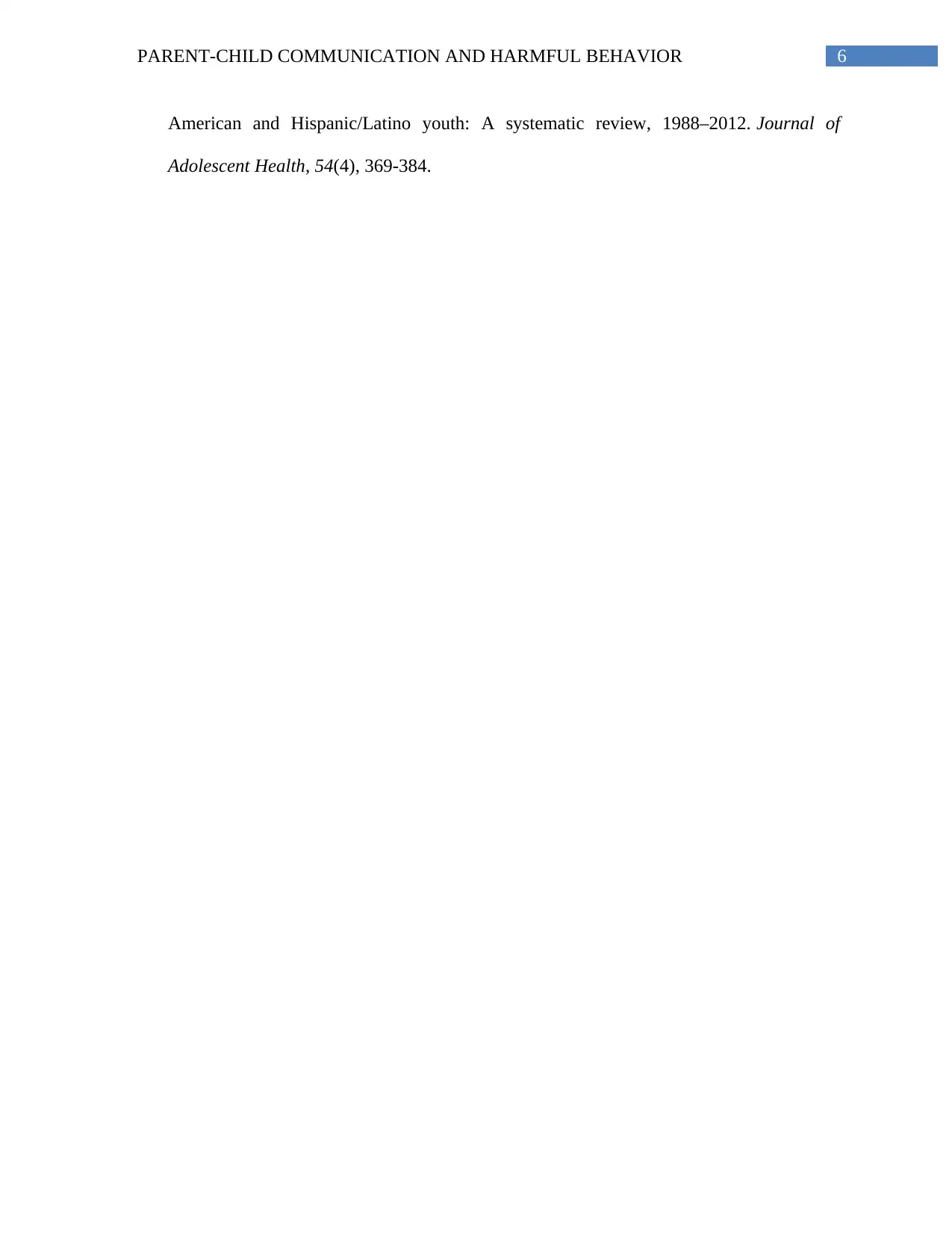
6PARENT-CHILD COMMUNICATION AND HARMFUL BEHAVIOR
American and Hispanic/Latino youth: A systematic review, 1988–2012. Journal of
Adolescent Health, 54(4), 369-384.
American and Hispanic/Latino youth: A systematic review, 1988–2012. Journal of
Adolescent Health, 54(4), 369-384.
1 out of 7
Related Documents
Your All-in-One AI-Powered Toolkit for Academic Success.
+13062052269
info@desklib.com
Available 24*7 on WhatsApp / Email
![[object Object]](/_next/static/media/star-bottom.7253800d.svg)
Unlock your academic potential
Copyright © 2020–2025 A2Z Services. All Rights Reserved. Developed and managed by ZUCOL.





